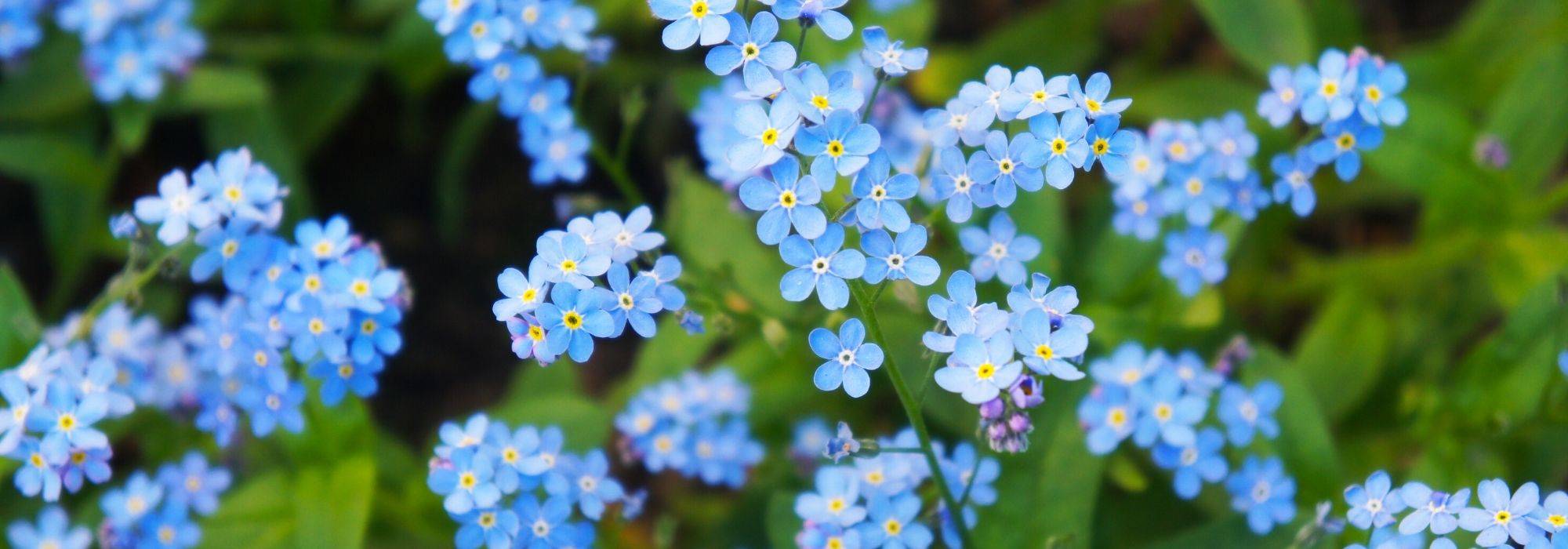
Myosotis: planting and sowing
Contents
Myosotis in a nutshell
- Forget-me-not is the simplest and most romantic of blue flowers
- It produces small, candid flowers in spring, usually blue, sometimes white or pink, on lovely pubescent foliage
- There are many species, the most common being wood forget-me-not (Myosotis sylvatica) and alpine forget-me-not (Myosotis alpestris)
- Easy to grow and hardy, it thrives in sun or partial shade, in cool, fertile soils, where it self-seeds abundantly
- It flourishes in woodlands, in borders, rockeries, and window boxes
A word from our expert
Myosotis is a graceful little perennial woodland plant, notable for its generous spring flowering with a romantic charm. Its fine and elegant stems bear clusters of star-shaped and delicate flowers, usually bright blue, sometimes pink or white depending on the varieties. These shades harmonise beautifully with the fresh green, pointed, and villous foliage that resembles mouse ears, hence its etymology (myós, “mouse” and ōtós, “ear”).
Alongside the field forget-me-not (Myosotis arvensis), there are many species, among which the wood forget-me-not (Myosotis sylvatica) and the alpine forget-me-not (Myosotis alpestris) are the most common in our gardens.
Although perennial and hardy, it is cultivated as an annual. But beneath its innocent appearance, it gradually spreads through sowing, abundantly over the years, timeless, almost eternal, hence its nickname “Forget-me-not”. In the language of flowers, it signifies fidelity and eternal love.
It forms dense and fairly wide clumps, unexpectedly creating a dazzling carpet at the foot of bulbs, along pathways, in pots, in woodland at the base of trees and bushes, and in borders with perennials. It adds a touch of freshness and highlights all the other spring bulbs alongside which it naturalises.
It thrives in non-burning sunlight as well as in partial shade on fresh, humus-bearing soil.
Discover our collection of seeds or plug plants of Myosotis ranging from sky blue to pure white, including pale pink, to create beautiful spring planters or to flower the garden in the first year of cultivation.
Description and botany
Botanical data
- Latin name Myosotis
- Family Boraginaceae
- Common name Myosotis, 'Forget-me-not'
- Flowering April-June
- Height 0.15 to 0.60 m
- Exposure Sun, Partial shade
- Soil type Draining, rich, cool
- Hardiness below -15°C
Myosotis, also known as “love grass” or “forget-me-not,” is a herbaceous plant from the Boraginaceae family, native to meadows, clearings, and forest edges in temperate regions of Europe. The genus comprises 50 species of myosotis, of which Myosotis sylvatica and Myosotis alpestris, or Alpine forget-me-not, are the most common and offer numerous cultivars with blue, white, or pink flowers. The colour of the flowers and the habit of these varieties can vary. These myosotis are very close to the Caucasian forget-me-not (Brunnera macrophylla), omphalodes, and bugloss. These four plants are quite similar in terms of their flowering. The Myosotis scorpioides, or marsh forget-me-not, also thrives in marshes, meadows, and wet woods, reaching heights of up to 60 cm.
Myosotis is a short-lived perennial, typically grown as an annual or even biennial.
It grows in clumps with a bushy habit, more or less compact, formed of small rosettes of foliage. Small in stature, it does not exceed 10 to 30 cm in height. Once well established, it will return on its own as it has a tendency to self-seed abundantly in the garden and naturalise!
Myosotis has very decorative deciduous foliage, valuable for adding a lot of freshness to a woodland garden. Its leaves alternate along the pubescent flower stems and are ovate to lanceolate, hairy, and rough. They are simple, entire, with a well-visible midrib and tapering to a point at the tip, resembling mouse ears. The entire plant is covered in short hairs characteristic of the Boraginaceae family. These leaves are light green to pale green in most myosotis. Some varieties also feature golden foliage, such as Myosotis alpestris ‘Aurea’.
From this rough vegetation, small flowers emerge from March to June, grouped in cymes at the tips of the branching stems in their upper part.
The flowers are gathered very densely but with an extreme lightness, reaching about twenty centimetres in length. They are small star-shaped inflorescences with a very delicate appearance, measuring 3 to 10 mm in diameter, composed of fused petals and 5 included stamens. They are generally a pure, extremely vivid blue, almost electric, close to indigo with a small yellow eye surrounded by pure white (Myosotis sylvatica ‘Royal Blue’, ‘Savoie Bleu’). Although less common, some varieties such as Myosotis sylvatica ‘Snowsylva’ (White sylva) offer pure white flowers. The flowers can also be bright soft pink with a lighter throat and speckled with a yellow centre, as seen in the varieties ‘Rose’ and ‘Rosylva’, or more rarely scarlet red in the Alpine forget-me-not ‘Roi Des Carmins’. This starry flowering stands out against the green foliage, with the shades harmonising gently to create a very fresh and natural appearance.
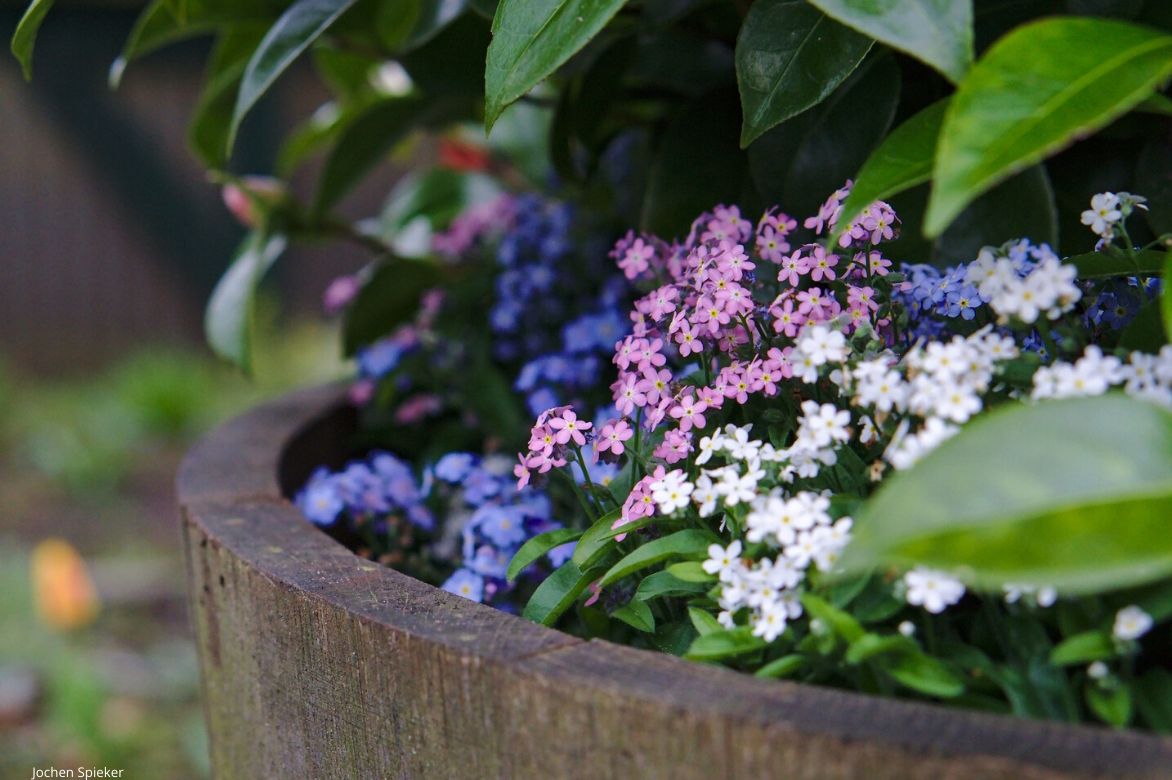
Flowers of Myosotis in various colours
The delicate flowers of myosotis add lightness to spring bouquets.
Slightly fragrant and melliferous, they attract pollinating insects. Small pods containing the seeds appear after flowering.
Easy to grow, myosotis adapts to any ordinary, cool soil, in partial shade or dappled sunlight in warm regions. It thrives in woodland and, with its bushy habit, will easily find its place in natural or wild and romantic gardens.
“`
Main species and varieties
Choose your myosotis in seeds or plug plants, available in blue, white, or pink flowers!
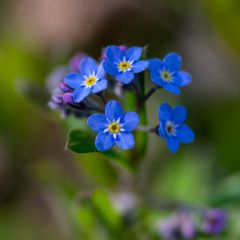
Myosotis sylvatica Bluesylva - Forget-me-not
- Flowering time April to July
- Height at maturity 20 cm
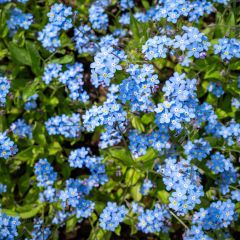
Forget-Me-Not Indigo Compacta Seeds - Myosotis sylvatica
- Flowering time May to July
- Height at maturity 20 cm
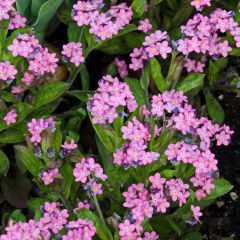
Pink Forget-Me-Not Seeds - Myosotis sylvatica
- Flowering time May to July
- Height at maturity 30 cm
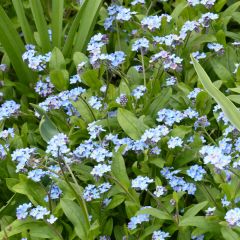
Blue Forget-Me-Not Seeds - Myosotis sylvatica
- Flowering time May to July
- Height at maturity 30 cm
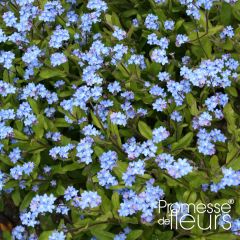
Myosotis sylvatica Savoie Blue
- Height at maturity 15 cm

Myosotis sylvatica Snowsylva - Forget-me-not
- Flowering time April to July
- Height at maturity 20 cm
Discover other Forget-me-nots
View all →Available in 0 sizes
Available in 4 sizes
Available in 3 sizes
Available in 3 sizes
Available in 1 sizes
Available in 2 sizes
Available in 1 sizes
Available in 2 sizes
Available in 1 sizes
Sowing and planting
Where to sow and plant Forget-Me-Not
Forget-Me-Not grows effortlessly in all our gardens, as it is a plant that naturally thrives in woodlands. However, it disappears with frost and is cultivated as an annual, but the plant self-seeds abundantly after flowering year after year, popping up unexpectedly wherever it pleases. While it adapts to any soil, it prefers rather cool, fertile, and well-drained soil.
It flourishes in non-burning sunlight or in the dappled shade of a woodland and will prefer a shaded exposure in our warmest regions.
Forget-Me-Not is very comfortable in the garden, in perennial borders, edges, and rockeries where it lightens the blooms. With its fresh flowering, it always creates scenes of great delicacy that are very natural and stands out in natural or wild gardens to bring lightness and a candid, romantic touch. It is particularly interesting for forming carpets of blue, white, or even pink flowers in the garden. For a beautiful decorative and spectacular effect, plant it in groups, in the shade of trees or elsewhere. It will also thrive in flowering pots and window boxes that adorn the terrace or balcony.
When and How to Sow
Sowing Forget-Me-Not is done in the nursery from May to early September and in open ground in August. “Sow it one day, and you’ll always have it!” is a motto written for it!
In seed trays
- Sow the seeds on the surface of moist, well-drained potting soil
- Cover them lightly with potting soil
- Seal in a polythene bag and keep your sowings between 15 and 20ºC
- Keep moist and in light during germination, which usually takes 14 to 30 days
- Transplant into individual pots
- Move to the garden in autumn when the plants have 5 to 6 leaves
- Water regularly to aid establishment
Sowings made in September will spend the winter in a cool, frost-free location and will be transplanted to the garden in spring when there is no more frost, spacing them 15 to 20 cm apart.
In open ground
- Sow broadcast in well-prepared soil at a depth of 6 mm, in rows spaced 30 cm apart
- Water lightly and keep moist to encourage germination
- Thin out, keeping only the strongest plants spaced 15-20 cm apart
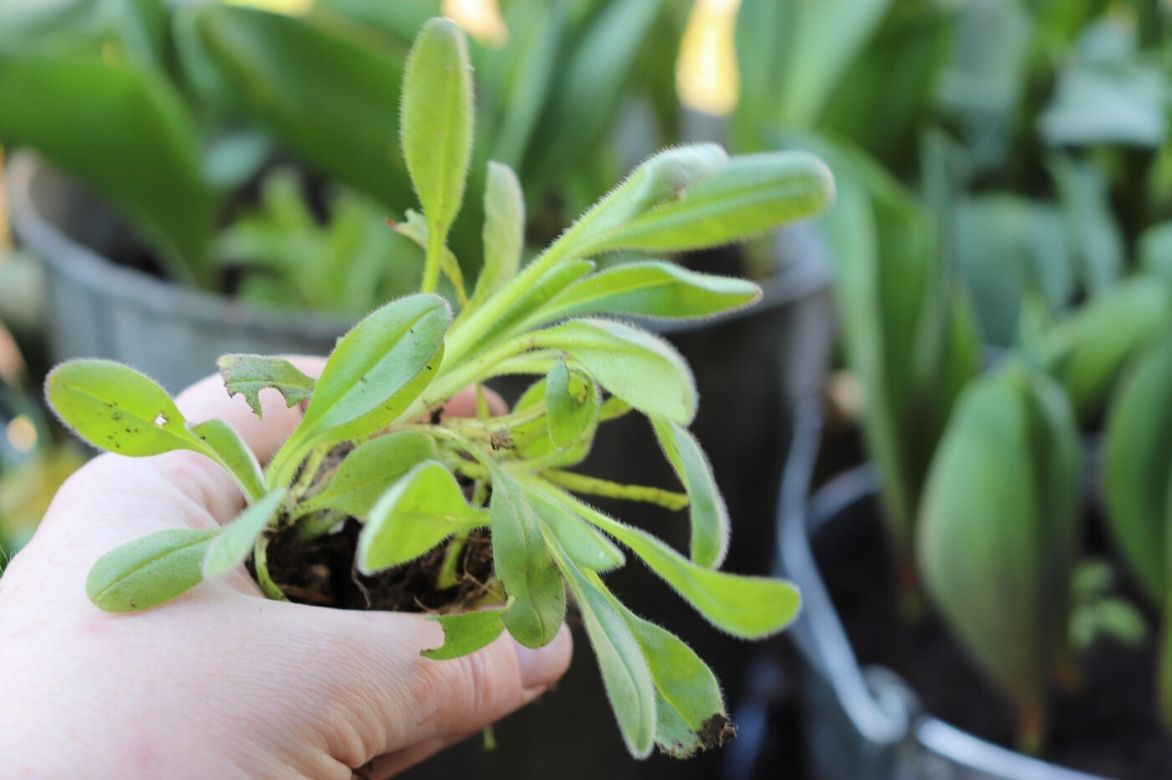
Transplanting Forget-Me-Not Seedlings
When and how to plant Myosotis?
If you prefer to opt for our Myosotis in plug plants, it’s just as simple! Planting Myosotis in open ground should preferably take place in autumn, from September to November for spring flowering the following year, or in March. You can plant them in groups (up to 16 plants per m²) in perennial beds, borders, or in a woodland area.
In open ground
- Space the plants 15 to 30 cm apart depending on the varieties
- Soak the pots in a basin of water
- Loosen the soil well
- Dig a hole three times the volume of the plug plant
- Spread gravel at the bottom of the planting hole
- Place the plug plant
- Backfill with garden soil mixed with a bit of compost as it prefers soils rich in organic matter, and gravel
- Firm down well
- Water generously
- Continue to water in the weeks following planting
Planting Myosotis in pots
You can plant Myosotis in pots or window boxes. Space the plants 15 cm apart.
- At the bottom of a drainage hole container, spread a layer of gravel or clay balls
- Fill half the pot with substrate
- Place and plant the plug plant in a well-draining mix of garden soil, coarse sand, and potting compost
- Cover and water regularly as soon as the soil is dry
Maintenance and care
Forget-me-nots require very little maintenance. As they prefer soil that remains fairly moist: water during summer droughts or if the weather is dry. However, they do not need a lot of water.
In pots or containers, ensure regular watering even in winter, but always without excess.
Cut the flower stems down to the ground after flowering, or leave a few in place if you want the plant to self-seed. Remove any overcrowded plants.
In spring, tidy up the clumps by removing dry leaves.
Diseases and potential pests
Little susceptible to diseases, forget-me-nots are only threatened by powdery mildew and slugs.
In warm, humid weather, a white fluff may appear on the leaves and young shoots. As a preventive measure, ensure there is enough space between the plants to avoid the appearance of the fungus. Water at the base without wetting the foliage and spray with nettle manure or Bordeaux mixture. You can find our tips for combating white disease.
The deciduous foliage disappears in winter, reappearing in spring, when the young leaves are a delight for slugs. Make sprays of fern manure to keep them away and discover our 7 ways to fight slugs effectively and naturally and how to make a slug trap.
Multiplication of Myosotis
By sowing
It multiplies very easily by sowing. It is in the nature of Myosotis to self-seed, but not always reliably in the garden. You can collect the young rosettes from these spontaneous sowings at the beginning of spring and replant them wherever you choose. You can also harvest some seeds in autumn and sow them as indicated in the section “When and how to sow Myosotis”.
By division
This technique has the advantage of being quick and it allows for the preservation of true varieties. You can proceed during spring.
- Dig up a clump with a fork, removing it carefully
- Divide a few outer sections with roots
- Clear excess soil around the roots
- Replant these sections without delay
- Firm the soil and water
Pairing ideas with forget-me-nots in the garden
Forget-me-nots are the perfect companion for other spring flowers. They have a knack for adding a touch of freshness and natural beauty to any scene, highlighting all other spring bulbs with their bright flowering. They create delicate floral cushions against a backdrop of Daffodils, Jonquils, and botanical tulips, in contrasting blue/yellow-green or in fresh white/blue scenes imbued with delicacy alongside wood anemones (Anemone nemorosa), Allium triquetrum, and white Scilla nutans.
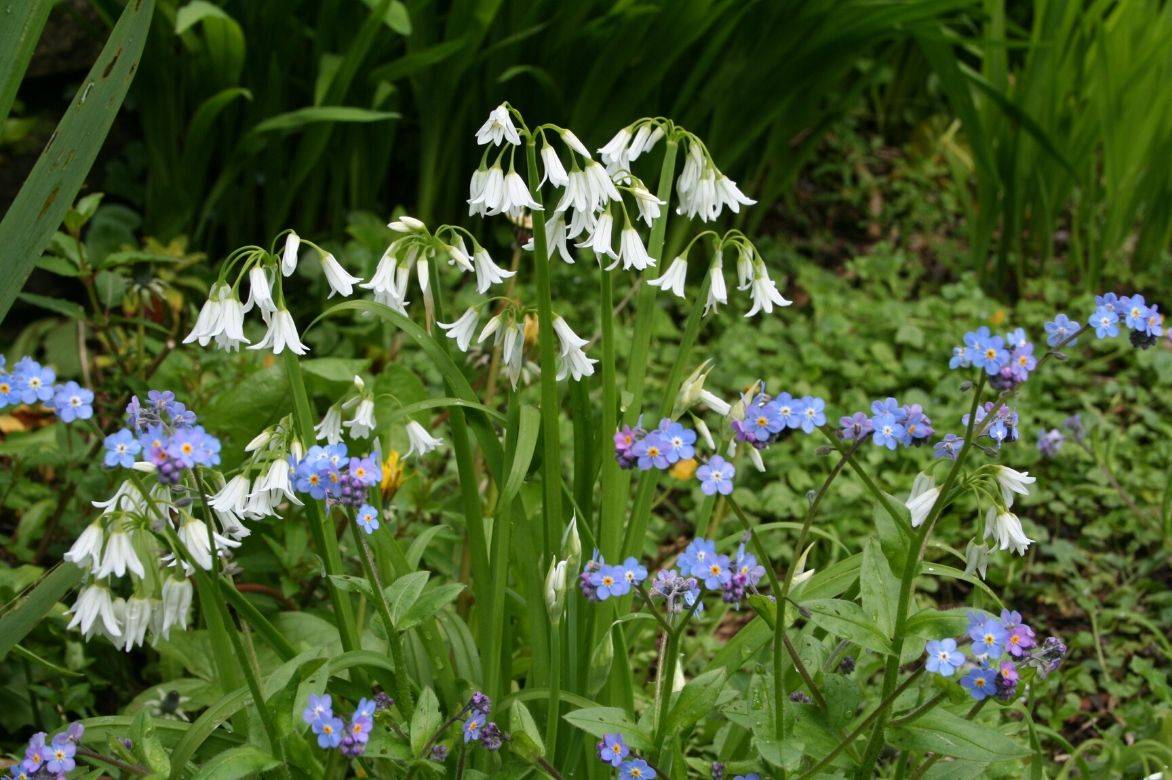
An example of a successful association: Forget-me-nots and Allium triquetrum
When planted en masse, they will form a light and graceful border along a path. For a fresh scene, plant forget-me-nots in large patches in woodland settings with ferns, Solomon’s seals, hostas, and epimediums. In a harmony of blue and purple tones, forget-me-nots also pair beautifully with pulmonarias and brunneras (Caucasian forget-me-nots), which are very close relatives and offer spring flowering. Create waves of blue flowers by pairing them with muscari (‘Mount Hood’, ‘Azureum’). Add the bright Corydalis ‘Blue Panda’ and Heuchera ‘Green Spice’!
In a flowerbed, with primroses like Primula veris, lady’s mantle, daisies, and Viola cornuta ‘Sorbet Xp F1 White’, they will compose a naive and romantic spring scene. Early pink tulips (Triumph Tulip ‘Pink Diamond’) or white (Triumph Tulip ‘Calgary’) are also good companions as their graceful flowering lightens the blooms. The Myosotis sylvatica ‘Rose’, a lovely pink-flowered variety, will be very decorative surrounded by Vinca minor ‘Atropurpurea’ at the base of roses or peonies to highlight their large voluptuous flowers. In a lovely planter, mix a forget-me-not with pansies, small daffodils, crocuses, muscari, or primroses.
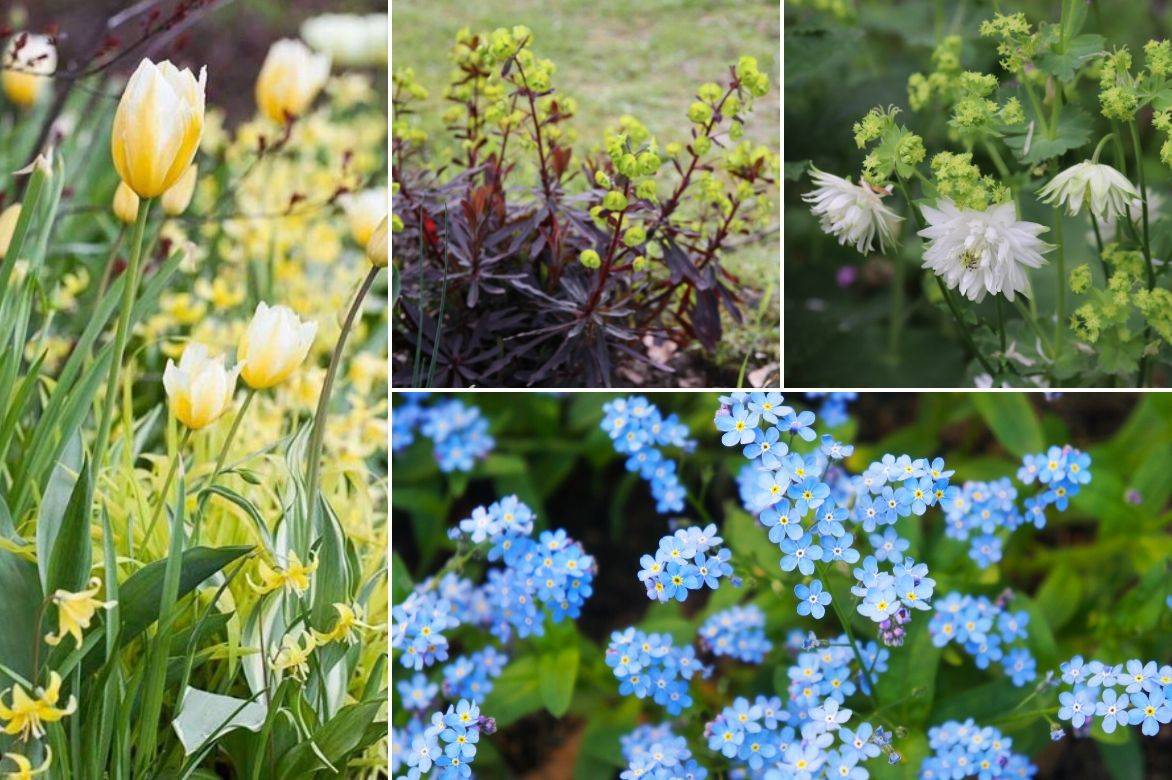
An idea for association: Tulip ‘Sweetheart’, Milium effusum ‘Aureum’, Erythronium pagoda, Euphorbia amygdaloïdes ‘Purpureum’, Aquilegia ‘Green Apples’, Alchemilla mollis, and forget-me-nots
Useful resources
- Discover our tips for growing a forget-me-not in a pot.
- How to sow forget-me-nots?
- Find all our annual flowers, as young plants (plug plants) or seeds!
- Subscribe!
- Contents
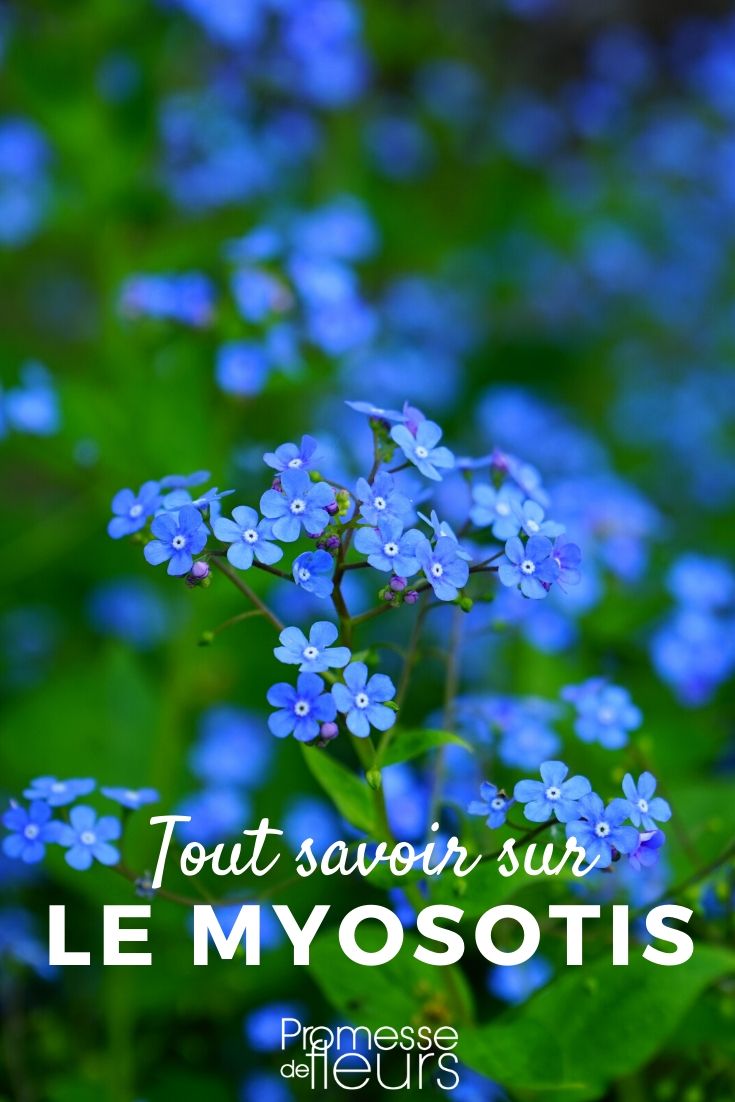































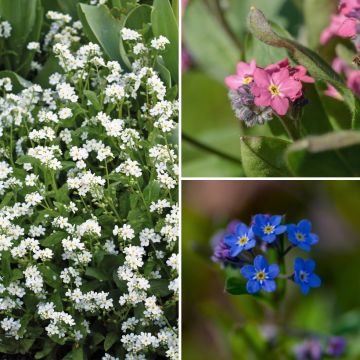

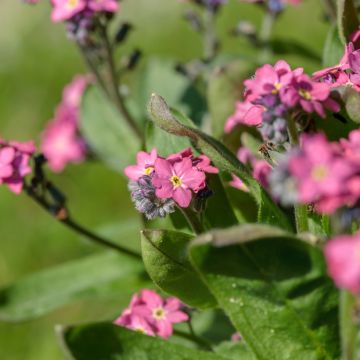

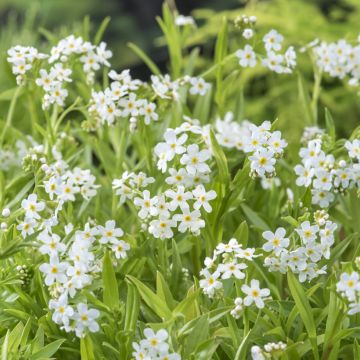



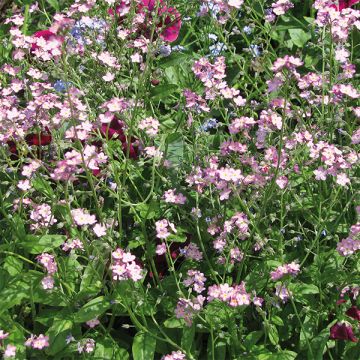
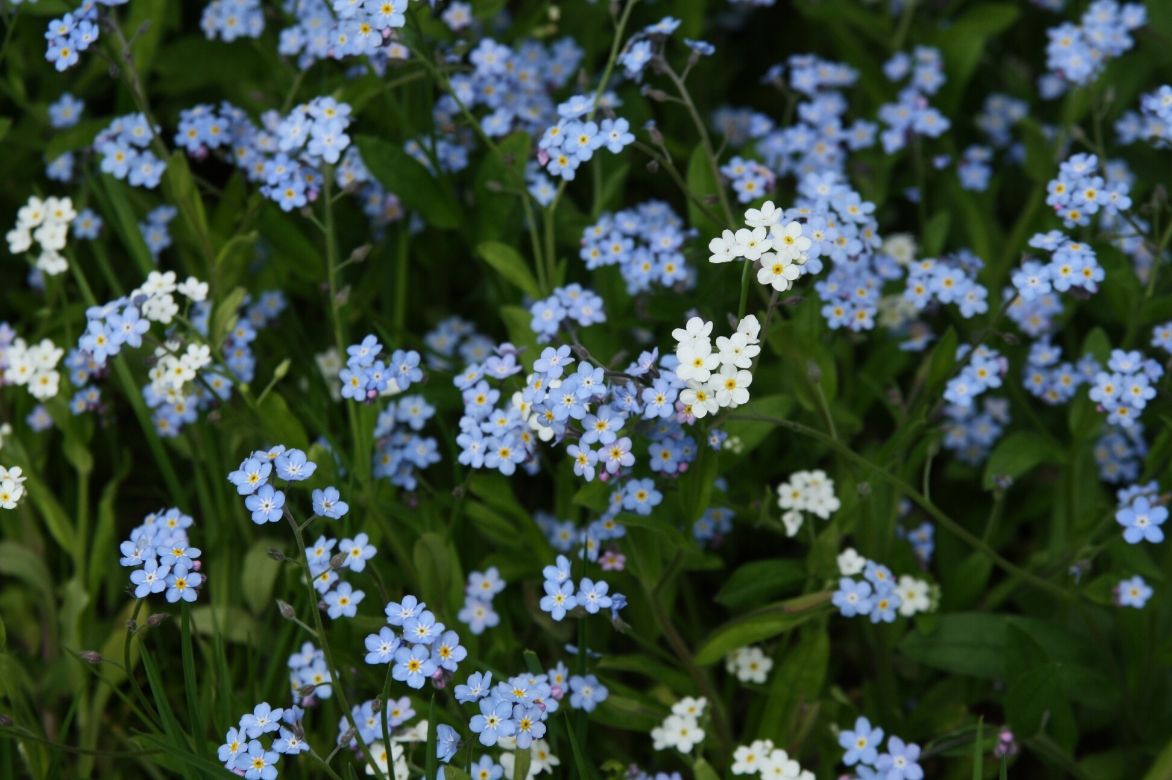
Comments